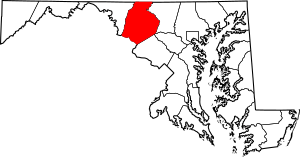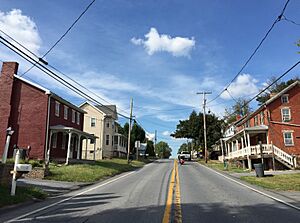Monocacy, Maryland facts for kids
Quick facts for kids
Monocacy, Maryland
|
|
|---|---|
|
Former Village
|
|

The former village of Monocacy was located near present-day Creagerstown in Frederick County, Maryland
|
|
| Country | United States |
| State | Maryland |
| County | Frederick |
| First Settled | Between 1725–1730 |
| Founded by | German settlers |
Monocacy was an old village in Frederick County, Maryland. It was located along an ancient Native American path called the Monocacy Trail. This trail followed the Monocacy River. Later, colonial travelers used it as the Great Wagon Road to Philadelphia, Pennsylvania. It was eventually renamed Monocacy Road.
Historical records show that Monocacy was the very first settlement in Western Maryland. People think the town was near today's Creagerstown. However, its exact location has been lost since it became an abandoned village in the early 1800s. There is proof that the town existed as far back as 1730.
Contents
History of Monocacy Village
Monocacy, Maryland, is known as the oldest settlement in Western Maryland. It was founded in the 1720s. The village was built close to the Monocacy Trail, an old Native American path. This trail ran along the Monocacy River.
Some historians believe the name "Monocacy" referred to the entire Monocacy Valley. This valley was where Moravian Germans from Pennsylvania settled. If this is true, Monocacy meant a larger area of settlements in 18th-century Frederick County, Maryland. This included Frederick Town, which was founded in 1745.
The earliest Monocacy settlement was likely active between 1721 and 1732. It was made up of European-American traders from the Maryland colony. They ran a trading post and lived alongside local Native American tribes.
German Settlers Arrive
In 1729, German settlers came to what would become Frederick County in 1748. At that time, it was part of the British colony of Maryland. The first settlement these settlers created was Monocacy. It was founded between 1725 and 1730. This makes it the oldest settlement in Western Maryland. The town was near the Monocacy Trail, an old Native American path along the Monocacy River.
By 1730, the Monocacy Trail was turned into a wagon road. In its early days, Monocacy was the most important settlement in the Frederick County region. However, the later founding and fast growth of Frederick Town (now Frederick, Maryland) eventually took over Monocacy's importance.
The Log Church and Village Life
Other records show that between 1732 and 1734, a church called "the Log church" was built. This church was likely in the main German settlement of Monocacy. Moravian Church missionaries often visited the area. Many people from "Manakasy" (the Native American tribe, as Moravians wrote it) also visited Moravian settlements in nearby Pennsylvania.
When the log church was built, Monocacy was quite important. The town had several taverns and places for travelers to stay. Even in 1747, Monocacy offered better lodging than Frederick. However, between 1760 and 1770, the nearby town of Creagerstown grew more important. Creagerstown was at a better location, at the crossroads of several early Maryland roads. This made it easier for stagecoach travelers and helped the town grow. By 1808, Monocacy Road was covered with macadam, making it a busy and reliable highway.


Searching for the Lost Town Site
As early as 1896, people no longer knew the exact location of Monocacy. In 1896, Rev. George A. Whitmore, who lived in Thurmont, interviewed two elderly residents of Creagerstown. They told him that Creagerstown was built on the old site of the Log Church. One of them, Mr. W.L. Grimes Sr., even helped tear down the old church to build a new one.
Whitmore also mentioned that old stories said the town of Monocacy was southeast of Creagerstown. It was supposedly at the meeting point of Monocacy Road and Poe's Ford, near Hunting Creek. Both Whitmore and his friend Mr. Schultz explored this area. They found flat land with a few old houses. Mr. Schultz was quoted in a history of Frederick County, saying this location "agrees in every particular with the data that we have heretofore been able to obtain." He believed the few old houses and a graveyard were all that remained of the ancient village of Monocacy.
In the late 1960s, a high school student named Charlotte Hearthly tried to find the site. Many local people believed their own land was where Monocacy once stood. However, much of the evidence for Monocacy's location has been destroyed over time. Spencer Geasey spoke of a place that once had a school, a cemetery, and other log buildings. He said this area was developed, so digging there now would not be helpful.
Proof of Monocacy's Existence
There is no doubt that the town of Monocacy existed. In August 1756, George Washington mentioned Monocacy in a letter. Two different traveling ministers also wrote about the log church at different times. They were riding trails about 10 miles north of Frederick. During the French and Indian War, the site was mentioned in the Maryland Gazette newspaper. In 1729, a complaint was filed by a Mr. Carroll with the Pennsylvania government. This complaint mentioned Monocacy because the area was disputed between Maryland and Pennsylvania.
The town was located near Creagerstown and Jimtown. According to Paul Gordon, one expert believes the Sebastian Derr house might have been a church and could be the old site of Monocacy.
The exact location of Monocacy has never been officially confirmed. There is a lot of evidence that the settlement was real. However, there is not enough clear physical evidence to show exactly where the town was.
Monocacy in the Media
In 1999, a documentary film called Monocacy was made about the region. It tells the history of the area and the lost town. Chris Haugh produced this film for GS Communications.

